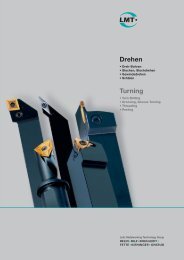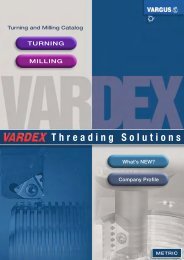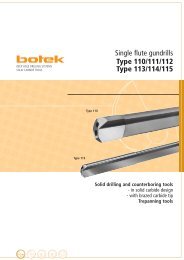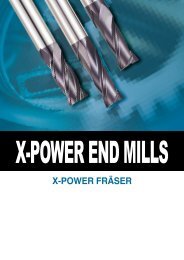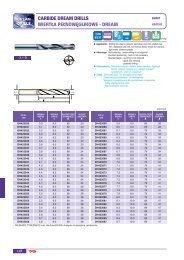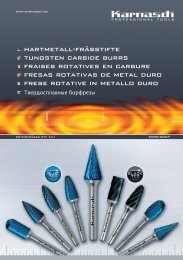Gear Cutting Tools
Hobs - Torion
Hobs - Torion
- No tags were found...
You also want an ePaper? Increase the reach of your titles
YUMPU automatically turns print PDFs into web optimized ePapers that Google loves.
Total<br />
a – Initial edge wear<br />
b – mechanical abrasion<br />
c – built-up edge<br />
d – oxidation<br />
e – diffusion<br />
e<br />
Wear<br />
d<br />
b<br />
c<br />
a<br />
<strong>Cutting</strong> speed/temperature<br />
Causes of wear against temperature (according to Vieregge)<br />
Hobbing has the additional phenomenon<br />
of strong local variations<br />
in stress upon the cutter teeth.<br />
This is a consequence of the tooth<br />
profile to be manufactured on the<br />
workpiece arising only with successive<br />
cuts of a number of cutter<br />
teeth engaging in turn. The metal<br />
removal capacity is provided principally<br />
by the tooth tips, which<br />
generate relatively large-volume<br />
chips capable of sinking a corresponding<br />
quantity of heat. By contrast,<br />
much thinner chips are generated<br />
in the region of the tooth<br />
flanks of the hob; the particular engagement<br />
conditions mean that<br />
the effective relief angle is also relatively<br />
small there, and the cut is<br />
characterized by a comparatively<br />
high frictional component which<br />
generates heat. At the same time,<br />
relatively thin, low-volume chips<br />
with a low heat-sinking capacity<br />
are generated. Consequently, a<br />
correspondingly high quantity of<br />
energy flows into the tool.<br />
The resulting locally exaggerated<br />
wear is compensated for by shifting.<br />
Shifting produces a more even<br />
tool stress distribution, with regard<br />
both to the hob as a whole, and to<br />
the individual cutter tooth. Both<br />
the abrasive and the thermally<br />
generated wear mechanisms are<br />
distributed more evenly over the<br />
tool.<br />
During coarse shifting, in particular,<br />
cutter regions temporarily uninvolved<br />
in the machining process<br />
have sufficient opportunity to cool<br />
down.<br />
The cutting conditions applicable<br />
to hobbing are principally the<br />
cutting speeds and the feeds.<br />
154



